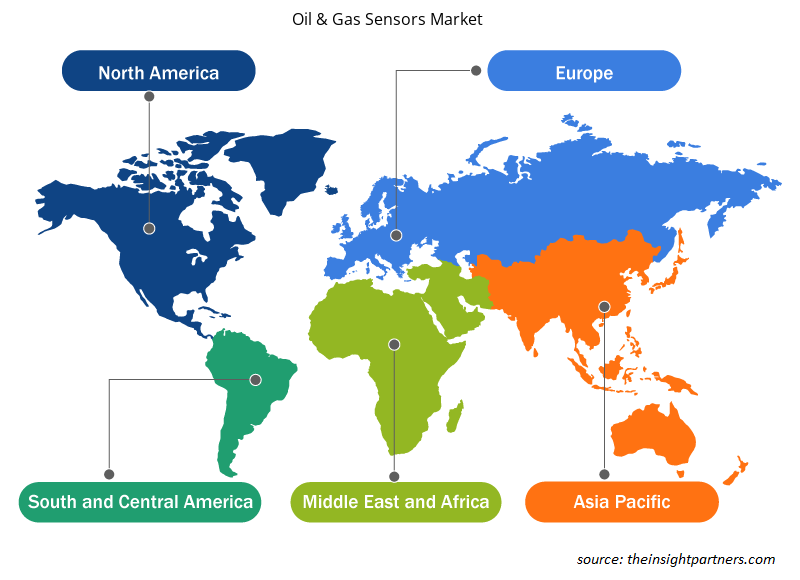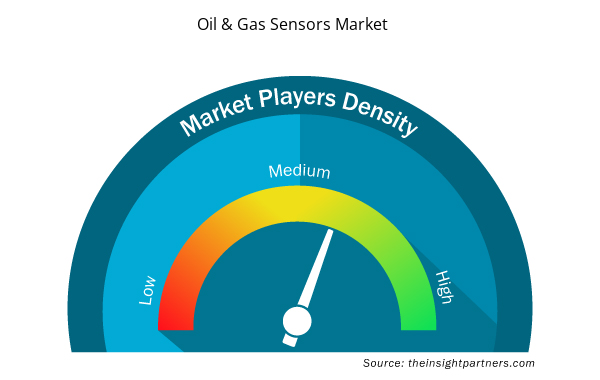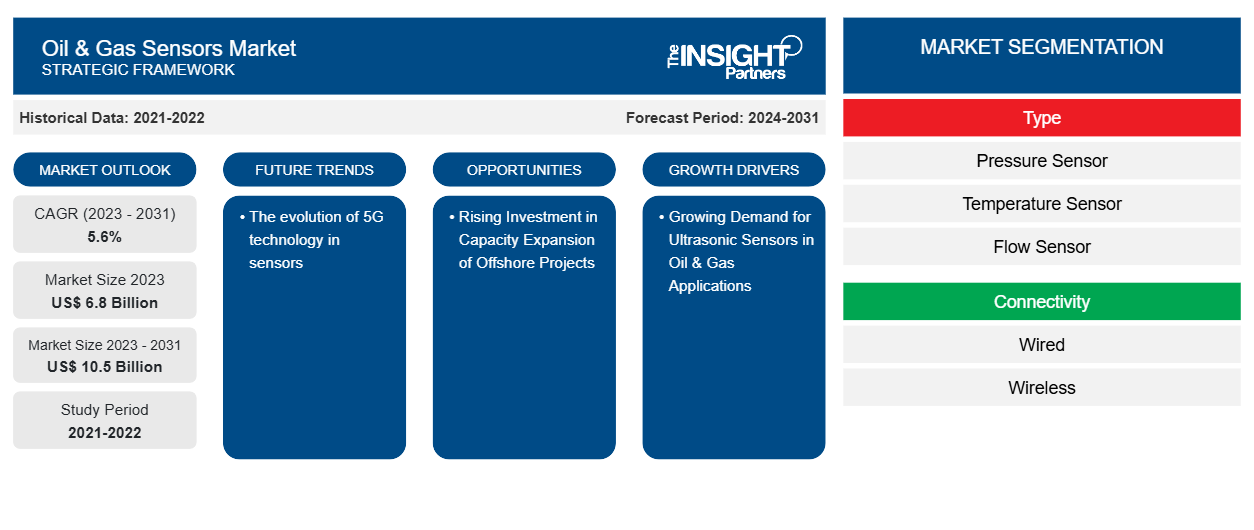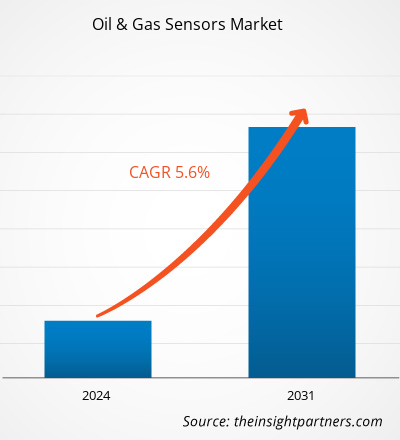石油・ガスセンサー市場規模は、2023年の68億米ドルから2031年には105億米ドルに達すると予想されています。市場は2023年から2031年にかけて5.6%のCAGRを記録すると予測されています。センサーにおける5G技術の進化は、今後も市場の重要なトレンドであり続けると思われます。
石油・ガスセンサー市場分析
石油・ガスセンサーは、パイプラインのパフォーマンスの最適化、流量の測定、漏れの検出、作業員の安全の確保による潜在的な事故や環境危険の防止など、上流、中流、下流のさまざまな用途に使用されています。運用の信頼性と効率性に対する需要の高まり、潜在的な危険の早期検出の必要性の高まり、産業自動化の増加、政府の好ましい取り組みが、石油・ガスセンサー市場を推進しています。さらに、石油・ガス産業の拡大と石油・ガスプラントのリアルタイム監視の必要性の高まりが、市場の成長を後押ししています。高度なセンサーの開発におけるAIやIoTなどの最先端技術の技術進歩と統合は、石油・ガスセンサー市場の成長に大きく貢献しています。
石油・ガスセンサー市場の概要
センサーは、環境内の物理的な入力の変化を検出して測定し、それを人間や機械が簡単に読み取れる出力に変換します。センサーは、物理現象を測定可能なアナログ電圧またはデジタル信号に変換し、それを表示または送信してさらに処理します。石油・ガスなどの業界では、温度の監視、距離の測定、圧力の調整、煙の検出などにセンサーを使用しています。石油・ガス業界では、予定外の中断や機械のメンテナンスを回避することで、石油・ガスプラントの継続的な監視と測定作業にセンサーを大いに活用しています。石油・ガスセンサーは、極めて高い温度や危険な環境に耐えることができ、防爆/本質安全、耐腐食性、防水/水中、防塵性 (IP 定格) を備えています。これらの機能は、石油・ガス業界が油井やパイプライン、海中アプリケーション、坑口計装、舵基準、貯蔵タンク、油井を正確に監視するのに役立ちます。
要件に合わせてレポートをカスタマイズする
このレポートの一部、国レベルの分析、Excelデータパックなど、あらゆるレポートを無料でカスタマイズできます。また、スタートアップや大学向けのお得なオファーや割引もご利用いただけます。
- このレポートの主要な市場動向を入手してください。この無料サンプルには、市場動向から見積もりや予測に至るまでのデータ分析が含まれます。
石油・ガスセンサー市場の推進要因と機会
石油・ガス分野における超音波センサーの需要増加
各国が脱炭素化された代替再生可能エネルギー源を模索する中、石油・ガス事業はますます重要になっています。しかし、石油・ガスの需要増加により、既存のインフラストラクチャからの生産量が増加し、より信頼性が高く効率的でなければなりません。これらの需要を満たすために、富士電機株式会社、ハネウェルインターナショナル株式会社、シーメンスAG、村田製作所株式会社などの石油・ガスセンサー企業は、厳しく複雑なプロセス条件で液体を測定する超音波センサーを提供しています。これらのセンサーは、さまざまな石油・ガスアプリケーションで、リモート監視、状態監視とメンテナンス、分析とシミュレーション、フロー制御に広く使用されています。超音波フローセンサーは、パイプライン、タンク、その他の処理機器内の流体の質量流量または体積流量を計算するために、上流、中流、下流のアプリケーションで使用されます。センサーは、監視ポンプ、フローライン、バルブ、および油の流れを維持するために正確な流量を必要とするその他のコンポーネントなどの機器も監視します。さらに、石油・ガスのミッドストリームおよびダウンストリーム用途における非侵入型測定の需要が高まっているため、精製および精製プロセスでのさまざまな化学反応中に液体の量を監視するための超音波センサーの必要性が高まっています。これらのセンサーは、進行中の操作を中断することなく、液体の流れを正確に監視します。
オフショアプロジェクトの能力拡大への投資増加
洋上風力や海洋エネルギーなどの洋上再生可能エネルギーは、新たな経済的、社会的機会を創出しながら、世界のエネルギー転換を加速させる可能性を秘めています。国際再生可能エネルギー機関(IRENA)が2023年6月に発表した最新データによると、洋上風力の容量は2022年に55ギガワット(GW)を超え、海洋エネルギーの設置容量は2021年に0.535GWでした。海洋エネルギー技術への投資の増加により、2030年までに洋上風力と海洋エネルギーはそれぞれ380GWと350GWを生成すると予想されています。これにより、水質の監視、油流出の検出、および洋上掘削活動が石油およびガス用途に与える影響を評価するために、ユーザーの間で石油およびガスセンサーの採用が促進されます。
石油・ガスセンサー市場レポートのセグメンテーション分析
石油・ガスセンサー市場分析の導出に貢献した主要セグメントは、タイプ、接続性、機能、およびアプリケーションです。
- タイプに基づいて、石油およびガスセンサー市場は、圧力センサー、温度センサー、フローセンサー、およびレベルセンサーに分類されます。圧力センサーセグメントは、2023年に最大の市場シェアを占めました。
- 接続性に基づいて、石油およびガスセンサー市場は有線と無線に分類されます。2023 年には有線セグメントが市場を支配しました。
- 機能別に見ると、市場はリモート監視、状態監視とメンテナンス、分析とシミュレーション、その他に分類されています。2023年にはリモート監視セグメントが市場を支配しました。
- 用途別に見ると、石油・ガスセンサー市場は上流、中流、下流に分かれています。上流セグメントは2023年に最大の市場シェアを占めました。
石油・ガスセンサー市場シェア分析(地域別)
石油・ガスセンサー市場は、北米、ヨーロッパ、アジア太平洋(APAC)、中東・アフリカ(MEA)、南米・中米の5つの主要地域に分かれています。2023年には北米が市場を支配し、ヨーロッパとAPACがそれに続きました。
北米における石油・ガスセンサー市場の成長は、エネルギー・電力部門で使用されるデバイスや機器の動作を監視するために、上流、中流、下流のアプリケーション全体で石油・ガスセンサーの採用が増えていることに起因しています。さらに、石油・ガス業界の拡大活動により、予測期間中に市場の成長に有利な機会が生まれると予想されています。
石油・ガスセンサー
石油・ガスセンサー市場地域別分析
予測期間を通じて石油・ガスセンサー市場に影響を与える地域的な傾向と要因は、Insight Partners のアナリストによって徹底的に説明されています。このセクションでは、北米、ヨーロッパ、アジア太平洋、中東、アフリカ、南米、中米にわたる石油・ガスセンサー市場のセグメントと地理についても説明します。

- 石油・ガスセンサー市場の地域別データを入手
石油・ガスセンサー市場レポートの範囲
| レポート属性 | 詳細 |
|---|---|
| 2023年の市場規模 | 68億米ドル |
| 2031年までの市場規模 | 105億米ドル |
| 世界のCAGR(2023年~2031年) | 5.6% |
| 履歴データ | 2021-2022 |
| 予測期間 | 2024-2031 |
| 対象セグメント | タイプ別
|
| 対象地域と国 | 北米
|
| 市場リーダーと主要企業プロフィール |
|
石油・ガスセンサー市場のプレーヤー密度:ビジネスダイナミクスへの影響を理解する
石油・ガスセンサー市場は、消費者の嗜好の変化、技術の進歩、製品の利点に対する認識の高まりなどの要因により、エンドユーザーの需要が高まり、急速に成長しています。需要が高まるにつれて、企業は提供を拡大し、消費者のニーズを満たすために革新し、新たなトレンドを活用し、市場の成長をさらに促進しています。
市場プレーヤー密度とは、特定の市場または業界内で活動している企業または会社の分布を指します。これは、特定の市場スペースに、その規模または総市場価値と比較して、どれだけの競合相手 (市場プレーヤー) が存在するかを示します。
石油・ガスセンサー市場で事業を展開している主要企業は次のとおりです。
- ハネウェルインターナショナル
- TEコネクティビティ株式会社
- ロバート・ボッシュ GmbH
- ABB株式会社
- シーメンスAG
- ロックウェル・オートメーション
免責事項:上記の企業は、特定の順序でランク付けされていません。

- 石油・ガスセンサー市場のトップキープレーヤーの概要を入手
石油・ガスセンサー市場のニュースと最近の動向
石油・ガスセンサー市場は、主要な企業出版物、協会データ、データベースを含む一次調査と二次調査後の定性的および定量的データを収集することによって評価されます。石油・ガスセンサー市場におけるいくつかの開発を以下に挙げます。
- 環境、社会、ガバナンス(ESG)ソリューションのイノベーターであるNevadaNanoは、シリーズCの資金調達ラウンドを完了したことを発表しました。このラウンドは、新規投資家のHoneywell VenturesとEmerson Venturesが主導し、既存の投資家数名が参加しました。(出典:NevadaNano、プレスリリース、2023年11月)
- ABB は、温度、湿度、二酸化炭素 (CO2)、VOC を監視して全体的な IAQ を改善し、ウイルスへの曝露リスクを軽減できるオプションの室内制御センサーを備えた非接触型室内センサーである新しい FusionAir Smart Sensor を発売しました。(出典: ABB Ltd、プレスリリース、2021 年 10 月)
石油・ガスセンサー市場レポートの対象範囲と成果物
「石油・ガスセンサー市場規模と予測(2021~2031年)」では、以下の分野を網羅した市場の詳細な分析を提供しています。
- 対象範囲に含まれるすべての主要市場セグメントについて、世界、地域、国レベルでの石油・ガスセンサー市場規模と予測
- 石油・ガスセンサー市場の動向、推進要因、制約、主要な機会などの市場動向
- 詳細なPEST/ポーターの5つの力とSWOT分析
- 主要な市場動向、世界および地域の枠組み、主要プレーヤー、規制、最近の市場動向を網羅した石油・ガスセンサー市場分析
- 市場集中、ヒートマップ分析、主要プレーヤー、石油・ガスセンサー市場の最近の動向を網羅した業界展望と競争分析
- 詳細な企業プロフィール
- 過去2年間の分析、基準年、CAGRによる予測(7年間)
- PEST分析とSWOT分析
- 市場規模価値/数量 - 世界、地域、国
- 業界と競争環境
- Excel データセット



Report Coverage
Revenue forecast, Company Analysis, Industry landscape, Growth factors, and Trends

Segment Covered
This text is related
to segments covered.

Regional Scope
North America, Europe, Asia Pacific, Middle East & Africa, South & Central America

Country Scope
This text is related
to country scope.
よくある質問
North America dominated the oil & gas sensors market in 2023.
The growing demand for ultrasonic sensors in oil & gas applications is the major factors that propel the market growth.
Evolution of 5G technology in sensors to play a significant role in the oil & gas sensors market in the coming years.
The key players holding majority shares in the global oil & gas sensors market are Honeywell International Inc, TE Connectivity Ltd, Robert Bosch GmbH, ABB Ltd, Siemens AG, Rockwell Automation Inc, Analog Devices Inc, Emerson Electric Co, SKF AB, and GE Vernova.
The oil & gas sensors market is anticipated to reach US$ 10.5 billion by 2031.
The oil & gas sensors market is estimated to record a CAGR of 5.6% from 2023 to 2031.
Trends and growth analysis reports related to Electronics and Semiconductor : READ MORE..
The List of Companies - Oil and Gas Sensors Market
- Honeywell International Inc
- TE Connectivity Ltd
- Robert Bosch GmbH
- ABB Ltd
- Siemens AG
- Rockwell Automation Inc
- Analog Devices Inc
- Emerson Electric Co
- SKF AB
- GE Vernova
The Insight Partners performs research in 4 major stages: Data Collection & Secondary Research, Primary Research, Data Analysis and Data Triangulation & Final Review.
- Data Collection and Secondary Research:
As a market research and consulting firm operating from a decade, we have published and advised several client across the globe. First step for any study will start with an assessment of currently available data and insights from existing reports. Further, historical and current market information is collected from Investor Presentations, Annual Reports, SEC Filings, etc., and other information related to company’s performance and market positioning are gathered from Paid Databases (Factiva, Hoovers, and Reuters) and various other publications available in public domain.
Several associations trade associates, technical forums, institutes, societies and organization are accessed to gain technical as well as market related insights through their publications such as research papers, blogs and press releases related to the studies are referred to get cues about the market. Further, white papers, journals, magazines, and other news articles published in last 3 years are scrutinized and analyzed to understand the current market trends.
- Primary Research:
The primarily interview analysis comprise of data obtained from industry participants interview and answers to survey questions gathered by in-house primary team.
For primary research, interviews are conducted with industry experts/CEOs/Marketing Managers/VPs/Subject Matter Experts from both demand and supply side to get a 360-degree view of the market. The primary team conducts several interviews based on the complexity of the markets to understand the various market trends and dynamics which makes research more credible and precise.
A typical research interview fulfils the following functions:
- Provides first-hand information on the market size, market trends, growth trends, competitive landscape, and outlook
- Validates and strengthens in-house secondary research findings
- Develops the analysis team’s expertise and market understanding
Primary research involves email interactions and telephone interviews for each market, category, segment, and sub-segment across geographies. The participants who typically take part in such a process include, but are not limited to:
- Industry participants: VPs, business development managers, market intelligence managers and national sales managers
- Outside experts: Valuation experts, research analysts and key opinion leaders specializing in the electronics and semiconductor industry.
Below is the breakup of our primary respondents by company, designation, and region:

Once we receive the confirmation from primary research sources or primary respondents, we finalize the base year market estimation and forecast the data as per the macroeconomic and microeconomic factors assessed during data collection.
- Data Analysis:
Once data is validated through both secondary as well as primary respondents, we finalize the market estimations by hypothesis formulation and factor analysis at regional and country level.
- Macro-Economic Factor Analysis:
We analyse macroeconomic indicators such the gross domestic product (GDP), increase in the demand for goods and services across industries, technological advancement, regional economic growth, governmental policies, the influence of COVID-19, PEST analysis, and other aspects. This analysis aids in setting benchmarks for various nations/regions and approximating market splits. Additionally, the general trend of the aforementioned components aid in determining the market's development possibilities.
- Country Level Data:
Various factors that are especially aligned to the country are taken into account to determine the market size for a certain area and country, including the presence of vendors, such as headquarters and offices, the country's GDP, demand patterns, and industry growth. To comprehend the market dynamics for the nation, a number of growth variables, inhibitors, application areas, and current market trends are researched. The aforementioned elements aid in determining the country's overall market's growth potential.
- Company Profile:
The “Table of Contents” is formulated by listing and analyzing more than 25 - 30 companies operating in the market ecosystem across geographies. However, we profile only 10 companies as a standard practice in our syndicate reports. These 10 companies comprise leading, emerging, and regional players. Nonetheless, our analysis is not restricted to the 10 listed companies, we also analyze other companies present in the market to develop a holistic view and understand the prevailing trends. The “Company Profiles” section in the report covers key facts, business description, products & services, financial information, SWOT analysis, and key developments. The financial information presented is extracted from the annual reports and official documents of the publicly listed companies. Upon collecting the information for the sections of respective companies, we verify them via various primary sources and then compile the data in respective company profiles. The company level information helps us in deriving the base number as well as in forecasting the market size.
- Developing Base Number:
Aggregation of sales statistics (2020-2022) and macro-economic factor, and other secondary and primary research insights are utilized to arrive at base number and related market shares for 2022. The data gaps are identified in this step and relevant market data is analyzed, collected from paid primary interviews or databases. On finalizing the base year market size, forecasts are developed on the basis of macro-economic, industry and market growth factors and company level analysis.
- Data Triangulation and Final Review:
The market findings and base year market size calculations are validated from supply as well as demand side. Demand side validations are based on macro-economic factor analysis and benchmarks for respective regions and countries. In case of supply side validations, revenues of major companies are estimated (in case not available) based on industry benchmark, approximate number of employees, product portfolio, and primary interviews revenues are gathered. Further revenue from target product/service segment is assessed to avoid overshooting of market statistics. In case of heavy deviations between supply and demand side values, all thes steps are repeated to achieve synchronization.
We follow an iterative model, wherein we share our research findings with Subject Matter Experts (SME’s) and Key Opinion Leaders (KOLs) until consensus view of the market is not formulated – this model negates any drastic deviation in the opinions of experts. Only validated and universally acceptable research findings are quoted in our reports.
We have important check points that we use to validate our research findings – which we call – data triangulation, where we validate the information, we generate from secondary sources with primary interviews and then we re-validate with our internal data bases and Subject matter experts. This comprehensive model enables us to deliver high quality, reliable data in shortest possible time.


 このレポートの無料サンプルを入手する
このレポートの無料サンプルを入手する